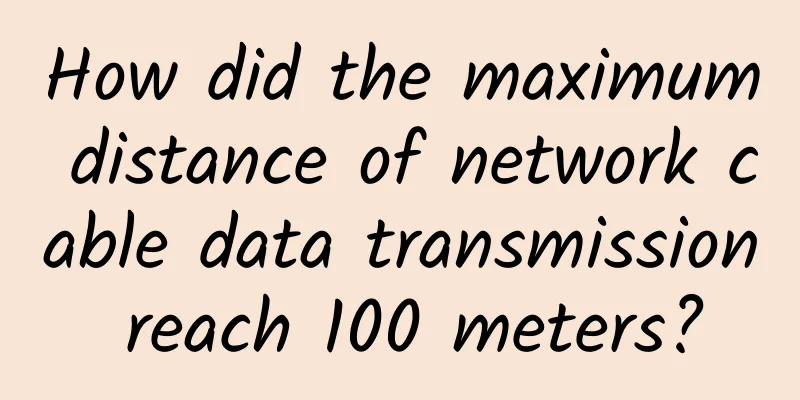How did the maximum distance of network cable data transmission reach 100 meters?

|
The maximum transmission distance of a network cable is usually 100 meters. So the question is, where does this 100 meters come from?
Maximum distance of data transmission via network cable Those who are familiar with the Internet know that twisted pair cables have an "insurmountable" transmission distance of "100 meters". Whether it is a Category 3 twisted pair cable with a transmission rate of 10M, a Category 5 twisted pair cable with a transmission rate of 100M, or even a Category 6 twisted pair cable with a transmission rate of 1000M, the maximum effective transmission distance is 100 meters. The integrated wiring specification also clearly requires that horizontal wiring cannot exceed 90 meters and the total link length cannot exceed 100 meters. In other words, 100 meters is a limit for wired Ethernet, and this limit is the link length from the network card to the hub device. How is the maximum distance of 100 meters obtained? What causes the 100-meter transmission distance limit of twisted pair cables? This requires a deep dive into the underlying physics of twisted pair cables. Network transmission is actually the transmission of network signals on twisted pair cables. As an electronic signal, it is inevitably affected by resistance and capacitance when transmitted in twisted pair cables, which leads to attenuation and distortion of network signals. When the signal attenuation or distortion reaches a certain level, it will affect the effective and stable transmission of the signal. Therefore, twisted pair cables have a transmission distance limit, so how do we calculate the upper limit of 100 meters? Category 5 UTP and Category 5e UTP are mainly used for computer networks. According to the 100Base-TX specification of Fast Ethernet, the communication rate is 100 mbps. The time it takes for 100 mbps Ethernet to transmit 1 bit of data (also known as "bit time") can be calculated as follows: 1 bit time = 1/100 Mbps = 10 ns When data information is transmitted in the network, it will be delayed when passing through different components. The delay of Category 5 UTP is 5.56ns/m. When designing Ethernet, a relay rule must be followed. This rule is also called the golden rule or the 5-4-3-2-1 rule. This rule applies not only to 10mbps Ethernet, but also to Fast Ethernet. This rule requires that the ring collision delay should not exceed 512 bits, which is 5120ns for a 100 Mbps transmission rate. In a ring, network elements include cables, relay units, MAUs, and DTEs. Adding up their delays and multiplying by 2 gives the ring delay, and the ring collision diameter can also be calculated. According to this theory, the maximum distance a signal can be transmitted before a minimum frame is sent can be calculated. This is why the link span is limited to 100 meters. When the distance exceeds 100 meters, the conflict cannot be detected in time, and the information packet damaged by the conflict is transmitted and received by the receiver. This information packet is forced to be discarded because it cannot pass the verification. At this time, the back-off retransmission mechanism is not activated, so the packet will be lost. When the transmission rate is lower than 100 mbps, the 100-meter limit can be appropriately relaxed in practical applications. It must be stated that although this is actually effective, it does not meet the standards. This must be stated during certification testing, otherwise it may cause some problems, such as product warranty. Maximum cable distance during actual construction From the above, we can see why the maximum length of the network cable is not allowed to exceed 100 meters when using PoE power supply. However, in actual construction, in order to ensure the quality of the project, it is generally 80-90 meters. Please note that the transmission distance here refers to the maximum rate, for example, 100M. If the rate is reduced to 10M, the transmission distance can usually be extended to 150-200 meters (depending on the quality of the network cable). Therefore, the PoE power supply transmission distance is not determined by the PoE technology, but by the type and quality of the network cable. Although in actual construction, high-quality network cables can break the 100-meter distance limit and the equipment can work normally, this practice is not recommended. Because some potential problems will not appear immediately, but will gradually appear over time, which will cause subsequent maintenance problems. The simplest case is, for example, the bandwidth upgrade, which makes the equipment that can work normally at a distance of more than 100 meters no longer work properly after the network speed is greatly increased. The impact of cable type and quality on transmission distance Category 5 cable: It is the most common standard network cable on the market now, but the quality of different manufacturers varies greatly. Especially in the price-oriented environment in China, many manufacturers replace copper wires with copper-clad iron and copper-clad steel to reduce costs, resulting in a decrease in the transmission distance of network cables, and even network instability and packet loss. Equipment manufacturers are often blamed, which is really unfair. Therefore, if you want to make the best use of PoE, you must use high-quality network cables, and you can't lose the big picture for the small, which affects the overall quality of the project. Category 5e cable (Cat 5e): Compared with Category 5 twisted pair cables, Category 5e twisted pair cables have less attenuation and crosstalk, can provide a more solid network foundation, meet most application requirements (especially support Gigabit Ethernet 1000Base-T wiring), bring convenience to network installation and testing, and become a better solution in current network applications. The transmission characteristics of Category 5e cables are the same as those of ordinary Category 5 cables, but the Category 5e wiring standard stipulates that all 4 pairs of Category 5e cables can achieve full-duplex communication. Category 6 cable (Cat 6): The transmission frequency of this type of cable is 1MHz~250MHz. The Category 6 wiring system should have a large margin in the comprehensive attenuation-to-crosstalk ratio (PS-ACR) at 200MHz, and it provides twice the bandwidth of Category 5e. The transmission performance of Category 6 wiring is much higher than the Category 5e standard and is most suitable for applications with transmission rates higher than 1Gbps. An important difference between Category 6 and Category 5e is: The performance in terms of crosstalk and return loss has been improved. For the new generation of full-duplex high-speed network applications, excellent return loss performance is extremely important. The basic link model is cancelled in the Category 6 standard. The wiring standard adopts a star topology structure. The required wiring distance is: the length of the permanent link cannot exceed 90 meters, and the channel length cannot exceed 100 meters. There is no strict difference between Category 6 and Category 5e in transmission distance, that is, the maximum transmission distance of a single segment is 100 meters. Of course, the transmission distance of Category 6 can be appropriately increased. The so-called 100 meters means that if it exceeds 1000 meters, it will not meet the relevant technical indicators such as 1000M bandwidth, resulting in problems such as speed reduction. |
<<: Build an HTTP experimental environment by yourself
>>: Rooted in China for 20 years, F5 "Code to User" Online Summit kicked off grandly
Recommend
A table to understand the difference between 5G and Wi-Fi 6
[[415279]] Spectrum Type Traditionally, cellular ...
Supply Chain Management Is Critical to SD-WAN
SD-WAN is not an all-encompassing solution; it is...
51% of companies said that lack of appropriate technical infrastructure and IT systems is a major challenge to digitalization
According to a survey conducted by the NASDAQ, wi...
The latest report on the value of the French 5G market: 100% 5G network is expected to be achieved by 2030
According to foreign media reports, in December 2...
Operators must solve ten problems before they have a chance to defeat WeChat
WeChat's powerful social functions have repla...
Why are WiFi 6 routers so expensive? Is the technology really that advanced?
We have mentioned the technical content related t...
ExtraVM: $5.5/month KVM-1GB/12G NVMe/1TB/Japan Data Center
ExtraVM is a foreign hosting company founded in 2...
The secret to a fast-growing business: SD-WAN technology
According to the latest survey statistics from a ...
Why does the HTTP request return 304?
[[402402]] I believe most web developers are fami...
The beauty of 5G phone is like being in your ear
[[352290]] This article is reprinted from the WeC...
How 5G will transform the patient experience
[[374198]] Image source: https://pixabay.com/imag...
How 5G deployment will impact enterprise network hardware and software
For most enterprises, IT teams will deploy fifth-...
5G, IoT and AI: Art and tech jobs for 2021
We are witnessing a massive transformation in the...
6 SD-WAN Challenges and Benefits
Software-defined WAN (SD-WAN) has obvious advanta...









